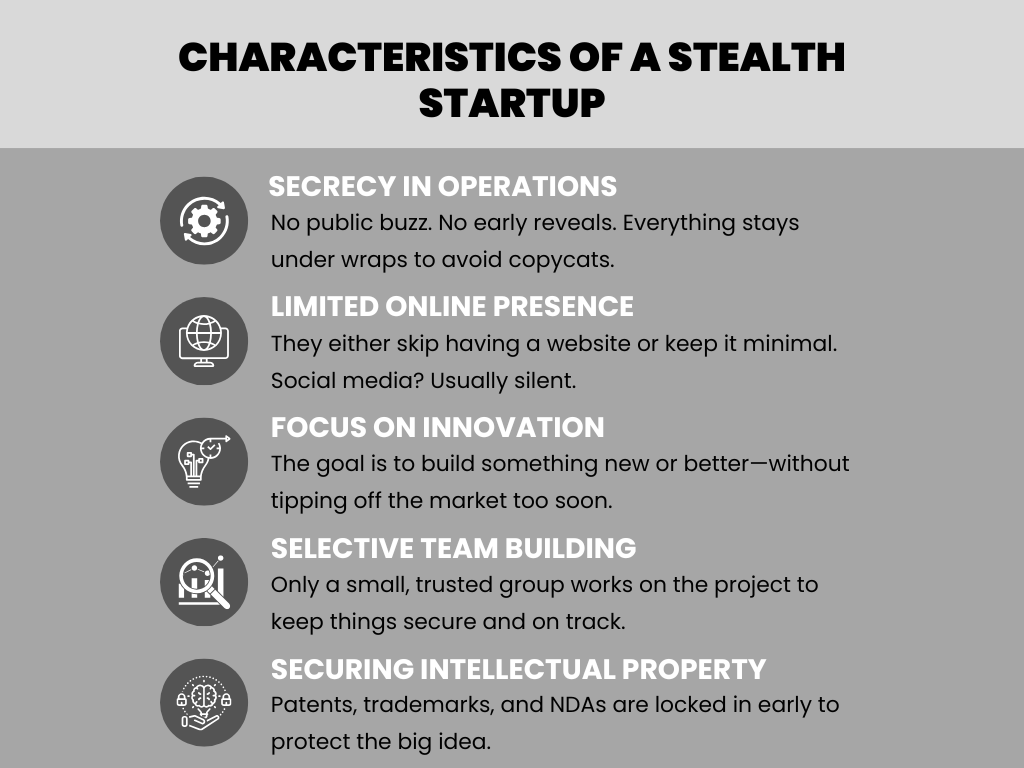
Written by Venturz Editorial Team, Business Experts
Category: Marketing and sales

Have you ever heard of a company that operates in secret before launching to the public? These are called stealth startups. A stealth startup is a business that works quietly behind the scenes, developing its products or services without drawing attention. They often avoid media coverage and keep their operations confidential until they are ready to reveal their work.
Why would a company choose to stay hidden?
The answer is strategy. Stealth startups protect their ideas from competitors, giving them a chance to innovate without outside pressure. This approach allows them to refine their product, test it privately, and make improvements before entering the market.
Stealth startups are not limited to any specific industry. They can be found in tech, healthcare, e-commerce, and more. For example, many big-name companies, like Tesla and Google, started as stealth projects before becoming household names.
In this article, we’ll explore everything you need to know about stealth startup.
A stealth mode startup is a company that operates in secrecy while it develops its product or service.
This strategy involves keeping business activities, goals, and progress confidential. By staying under the radar, these startups avoid competition, media attention, and public scrutiny until they are ready to launch.
Stealth mode startups often focus on innovation. They work quietly to solve problems, create new solutions, or improve existing products. During this time, they might also secure patents, build prototypes, and test their ideas with a small, trusted group.
Think about Siri, Apple’s voice assistant. Before its public release, Siri was developed by a stealth startup called Siri Inc. The company worked quietly on its technology until it was ready for a public launch. Once Apple acquired Siri, the product became a key feature of iPhones.
Stealth mode startups use this secrecy to refine their ideas and build a strong foundation. While their approach might seem mysterious, it often leads to groundbreaking products that make a big impact when they finally go public.

Stealth startups are unique in how they operate compared to traditional businesses. Their focus on secrecy and innovation sets them apart.
Here are the key characteristics that define a stealth startup:
Stealth startups work quietly. They keep their projects confidential to avoid attention from competitors or the public. This means no marketing campaigns, public announcements, or product previews during the early stages.
These startups often lack a website or social media presence. If they do have an online footprint, it typically contains minimal information to maintain privacy.
Stealth startups aim to create unique solutions or improve existing technologies. They use secrecy to protect their ideas until they are fully developed.
They hire a small, trusted team of experts to work on the project. This helps maintain confidentiality and ensures the quality of the product.
Many stealth startups prioritize filing patents or securing trademarks to protect their work before unveiling it to the public.
Yes, a stealth startup is a real company. It functions just like any other business but operates in secrecy during its early stages. These startups focus on developing their products, securing funding, and building their team without publicizing their activities.
Here is how stealth startups operate as real companies:
- Legal Structure: Stealth startups are registered businesses with formal structures, such as LLCs or corporations. They follow legal and financial protocols, just like traditional companies.
- Team and Operations: They have employees, offices, and operations, but their work remains confidential. Team members are often bound by non-disclosure agreements (NDAs) to maintain secrecy.
- Funding and Investors: Stealth startups raise capital from venture capitalists, angel investors, or private equity firms. The funding is real, even if the details of the project are not disclosed.
- Product Development: The company actively works on its product or service behind the scenes, refining it before making a public announcement.
A stealth mode startup is a company that is in the process of developing a new product or service. It is not yet known to the public.
Whereas a traditional startup is a company that has already launched its product or service to the public and has been successful in gaining traction with its customers.
The difference between stealth startups and traditional startups can be seen in how they handle the process of launching. A traditional startup will start by building a prototype, testing it on customers, and scaling up. Most tech and software startup ideas follow this approach for soft launching.
A stealth startup will launch a product incurring low costs that is not fully developed. The idea behind this approach is to get customer feedback before investing too much time into developing the product.
Traditional startups have an advantage because they have already built up some momentum with their customers, and they can use this as leverage for getting investors on board.
A Startup in stealth mode can be a difficult endeavor because it's hard to get investors on board without any traction or proof of concept for your idea. Another challenge for stealth startups is that you can't rely on word-of-mouth marketing because nobody knows your company yet.
Stealth startups operate discreetly, making them challenging to identify. However, by observing specific patterns and behaviors, you can uncover clues about their existence.
Here’s how you can spot them:
Stealth startups often maintain a very limited online presence. Stealth startup website, typically contains little more than a logo or basic contact details. Social media accounts may either be nonexistent or inactive. This deliberate lack of information helps them avoid drawing attention while they work on their projects.
Many stealth startups recruit talent by posting anonymous or ambiguous job listings. For example, a posting might describe the role as “part of a groundbreaking team in a confidential project” without naming the company. They also tend to avoid sharing details about their product or target market in these postings to maintain secrecy.
Stealth startups often secure funding through venture capitalists or angel investors, but these deals are typically low-profile. You might notice reports of large investments made into companies that seem to lack a defined product, public presence, or operational details. This can be a sign of a stealth startup preparing for a significant launch.
The individuals behind stealth startups usually avoid media attention. Unlike traditional startups where founders actively promote their vision, those running stealth startups rarely share updates, give interviews, or engage in public discussions about their business.
Though stealth startups aim to stay hidden, their work might surface through technical filings. They may file patents to protect their innovations, offering hints about their focus. For instance, a patent for an advanced battery design could indicate work in energy storage or electric vehicles.
Here are some ways to build a successful startup in stealth mode.
The first step to building a successful stealth startup is to build a unique product. This is not a very complicated task, but it is extremely important that the product be as different from any other product in the market as possible. This can include the latest tech trends like AI, SaaS, and IoT. You can use various ideation tools and some ideation techniques to generate ideas for a unique product.

When you want to start a stealth startup, finding the right partner is important. This will help you cover your tracks from competitors and save you from wasting money on marketing campaigns that are doomed to fail.
Also, finding partners who can help with your product development is essential.
But how to find the partner that's the right fit for you? There are many ways to find partners, including social media platforms like LinkedIn, Facebook, or Twitter to find potential partners. You can also use other sources on the internet to search for potential partners who might be interested in your idea and willing to help you out with it.
A successful stealth startup should have an idea that can be executed without much competition or risk. There are many ways to avoid competition, but a good way to start is to make sure your idea stands out from others in its field.
This could be accomplished by thinking of a new way to solve an old problem or creating something that has never been seen before.
One way to do this is by creating a product or service in high demand but with a low supply. This will allow the startup to take advantage of the market opportunity and stand out from competitors with less supply.
The goal of any startup is to avoid risk. That is why stealth startups are so popular. They keep their plans and ideas secret until they are ready to launch.
There are many ways to reduce risk in a startup, but the most important one is not to spend too much money before the product is ready for market. This means that you should not hire staff before you have a clear idea of how much money you will need in order to get your product off the ground and running.
Successful stealth startups are realistic about financing. They understand that they might not be able to raise venture capital and might have to bootstrap their startup with a small amount of money.

There is no standard limit for how much money you should have in order to start your stealth startup. The only common thing is that you should be realistic about financing and not overestimate your ability to raise funds from VCs or other sources.
In the early stages, your brilliant ideas are like treasures. Stealth mode acts like a protective shield, ensuring no one sneaks a peek before you're ready to share. This way, your unique concepts stay yours, and yours alone.
When you're under the radar, there's no rush from outside voices. It's like having a private workshop where you can tweak, test, and refine. This quiet time lets you ensure everything's just right, making your eventual debut even stronger.
In the business world, timing is everything. Being in stealth mode allows you to strategically decide when to unveil your product or service. This ensures you capture the market's attention at the most opportune moment, maximizing impact and potential success.
Launching too soon can attract critiques based on unfinished ideas or products. Stealth mode lets you refine and polish without external pressures, ensuring that when you do step forward, it's with confidence and a product you're proud of.
Just like a buzz before a big product release, stealth mode creates whispers in the business community. By keeping details under wraps, you spark interest and speculation. When you finally unveil, the heightened curiosity can lead to a more engaged and eager audience, ready to see what you've been crafting.
When you're operating in the shadows, many doors remain closed. You might overlook potential allies, mentors, or partners who could bring invaluable insights or resources to your venture. By staying stealthy, you risk missing out on these golden chances to collaborate and elevate your startup to new heights.
While you're keeping things under wraps, a competitor might launch something similar. They could grab the spotlight and set industry standards, making your eventual reveal seem like a mere echo rather than a groundbreaking announcement.
Keeping your startup's details a secret means fewer eyes and ears on your project. This can restrict the flow of feedback, both positive and constructive. Without diverse opinions and early user experiences, you might miss crucial adjustments, potentially leading to a product that doesn't fully resonate with its intended audience.
Investors like to see clarity, progress, and confidence. Operating in stealth can sometimes send mixed signals. They might question, "Why the secrecy?" or "Is there a lack of readiness?" Such doubts can make them think twice before backing your venture, potentially limiting your access to crucial funding.
The longer you remain in stealth mode, the taller the tales and expectations grow. The business community awaits a grand reveal, and this mounting anticipation can create immense pressure on your startup. Meeting these sky-high expectations can be daunting, and any shortfall might be magnified in the eyes of your audience.
Choosing the right location to operate a stealth mode startup is essential for maintaining privacy and ensuring productivity. Each option has its benefits depending on the company’s needs and level of secrecy. Here are three popular choices:
Coworking spaces offer shared office environments where startups can rent desks or private rooms. For stealth mode startups, coworking spaces provide access to professional facilities and networking opportunities while maintaining some level of privacy.
- Advantages: Affordable and flexible leasing options. Access to high-speed internet, meeting rooms, coworking software, and office supplies. Opportunity to meet other entrepreneurs and investors.
- Considerations for Privacy: Stealth startups should choose coworking spaces that offer private offices or secluded areas to protect confidential discussions and project details.
A home office is often the simplest and most private option for running a stealth startup. This setting allows founders to work in complete control of their environment, minimizing risks of information leaks.
- Advantages: Full privacy and control over workspace. No commute, saving time and money. Cost-effective for small teams or solo founders.
- Challenges: Limited access to professional resources like meeting rooms or large equipment. Potential distractions from household activities.
Innovation hubs are specialized spaces designed to support startups. These hubs offer resources like advanced technology, mentorship programs, and funding connections. For stealth mode startups, innovation hubs with secure and private facilities are an excellent choice.
- Advantages: Access to industry-specific tools and technologies. Collaboration with experts and mentors. Opportunities to connect with potential investors.
- Considerations for Privacy: Look for hubs that prioritize confidentiality agreements and private spaces to ensure sensitive projects remain undisclosed.
Running a startup in stealth mode has its pros and cons. For most businesses, being open allows for valuable feedback, easier access to talent, and connections with investors. However, stealth mode can be a good fit if your idea is disruptive, easy to copy, or involves technology that needs time to mature.
That said, remember that competitors aren’t likely to rush into copying your idea overnight. Success is about execution, not just the concept. If full secrecy feels too restrictive, consider a semi-stealth approach. You can stay quiet publicly while reaching out to trusted advisors and gathering feedback.
In the end, whether to use stealth startup mode depends on your specific goals. Choose what helps you build confidently and move closer to your vision.

ABOUT THE AUTHOR
Venturz Editorial Team
The Venturz Editorial Team is a group of experienced creators, product specialists, and business strategists dedicated to empowering entrepreneurs. We publish clear, actionable insights on business setup, growth, marketing, automation, and productivity — helping founders make confident, informed decisions as they build and scale their ventures.
or
Startup Events
Live Chat
